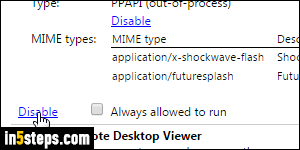
In the Block or Allow sections, find the site you want to change Flash permissions for, then click the trash can icon to remove it from the list.Here’s how to change Flash permissions using Chrome’s Settings tab. Select the permission you want for the site.

Click the padlock to the left of the address bar.Here’s how to change Flash permissions for a single site. Let’s say you accidentally blocked Flash content on a certain site, or worse, accidentally allowed Flash content when you meant to block it! There are two ways to revoke or change Flash permissions for a site in Chrome. How to change Flash permissions in Google Chrome The page will refresh and the Flash content will start as it should. This could be a hassle if you have to deal with tons of Flash media every day, but otherwise it’s a safe move, if you trust the site! When you click, you’ll get a notification asking if you want to allow or block Flash for the current site. With Flash enabled in Chrome, every time you visit a web page with Flash content, you must click the Flash player to launch it. How to play Flash content in Google Chrome Enable the setting for the label to say Ask first (recommended).Under Privacy and Security, click Site Settings.
 Scroll to the bottom and click Advanced. Open the three-dot menu and select Settings. Here’s how to enable Flash Player in Chrome. In the report, you can learn if there are any issues found with your site that you can address.Check How to Enable/Disable Flash in Chrome With the run command window open, ensure the information is correct, and click Execute. Next, right-click on the Adobe Player installation and click Uninstall. With the computer details windows open, click the Application option in the left panel. If pop-ups get blocked on a site that you own, go to the Abusive Experience Report. Double click on any machine that has Adobe Flash installed. My site's popups are being blockedĬhrome blocks pop-ups that users might not find useful. You can control specific ways a website acts when you use Chrome. Learn how to use a managed Chrome device. Using a Chrome device at work or school: You can't change this setting yourself, but your network administrator can set up the pop-up blocker for you. You can read other options to find and remove malware from your computer. Still getting unwanted pop-ups: Try to run the Chrome Cleanup Tool (Windows only). You can also block notifications from your site settings. Next to "Notifications," select Block from the drop down menu. Go to the site you get notifications from. If you still get communications from a site after disabling pop-ups, you may be subscribed to notifications. To capture all pop-ups across the site, use the pattern. Enter the site's web address, and then click Add. If the site isn't listed, next to "Not allowed to send pop-ups or use redirects," click Add. To the right of the site, click More Block. Under "Allowed to send pop-ups and use redirects," find the site.
Scroll to the bottom and click Advanced. Open the three-dot menu and select Settings. Here’s how to enable Flash Player in Chrome. In the report, you can learn if there are any issues found with your site that you can address.Check How to Enable/Disable Flash in Chrome With the run command window open, ensure the information is correct, and click Execute. Next, right-click on the Adobe Player installation and click Uninstall. With the computer details windows open, click the Application option in the left panel. If pop-ups get blocked on a site that you own, go to the Abusive Experience Report. Double click on any machine that has Adobe Flash installed. My site's popups are being blockedĬhrome blocks pop-ups that users might not find useful. You can control specific ways a website acts when you use Chrome. Learn how to use a managed Chrome device. Using a Chrome device at work or school: You can't change this setting yourself, but your network administrator can set up the pop-up blocker for you. You can read other options to find and remove malware from your computer. Still getting unwanted pop-ups: Try to run the Chrome Cleanup Tool (Windows only). You can also block notifications from your site settings. Next to "Notifications," select Block from the drop down menu. Go to the site you get notifications from. If you still get communications from a site after disabling pop-ups, you may be subscribed to notifications. To capture all pop-ups across the site, use the pattern. Enter the site's web address, and then click Add. If the site isn't listed, next to "Not allowed to send pop-ups or use redirects," click Add. To the right of the site, click More Block. Under "Allowed to send pop-ups and use redirects," find the site. 
Click Privacy and security Site Settings.







 0 kommentar(er)
0 kommentar(er)
